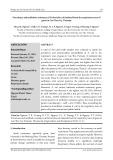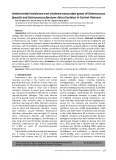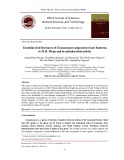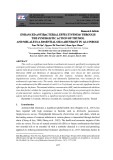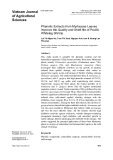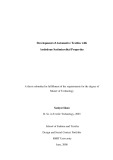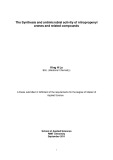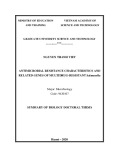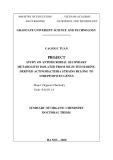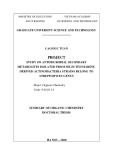A vertebrate slow skeletal muscle actin isoform Wasana A. K. A. Mudalige, Donna M. Jackman, Deena M. Waddleton and David H. Heeley
Department of Biochemistry, Memorial University of Newfoundland, St John’s, Canada
Keywords actin; muscle plasticity; protein isoforms; salmonid fishes; slow skeletal muscle
Correspondence D. Heeley, Department of Biochemistry, Memorial University of Newfoundland, St. John’s, Newfoundland A1B 3X9, Canada Fax: +1 709 737 2422 E-mail: heeleydavid@yahoo.com
Database The novel amino acid sequences published here are available under the accession num- bers AF304406 (Atlantic salmon fast skeletal muscle actin), AF267496 (brown trout slow skeletal muscle actin) and AF303985 (brown trout cardiac muscle actin)
(Received 4 March 2007, revised 5 May 2007, accepted 11 May 2007)
doi:10.1111/j.1742-4658.2007.05877.x
Salmonids utilize a unique, class II isoactin in slow skeletal muscle. This actin contains 12 replacements when compared with those from salmonid fast skeletal muscle, salmonid cardiac muscle and rabbit skeletal muscle. Substitutions are confined to subdomains 1 and 3, and most occur after residue 100. Depending on the pairing, the ‘fast’, ‘cardiac’ and rabbit actins share four, or fewer, substitutions. The two salmonid skeletal actins differ nonconservatively at six positions, residues 103, 155, 278, 281, 310 and 360, the latter involving a change in charge. The heterogeneity has altered the biochemical properties of the molecule. Slow skeletal muscle actin can be distinguished on the basis of mass, hydroxylamine cleavage and elec- trophoretic mobility at alkaline pH in the presence of 8 m urea. Further, compared with its counterpart in fast muscle, slow muscle actin displays lower activation of myosin in the presence of regulatory proteins, and weakened affinity for nucleotide. It is also less resistant to urea- and heat- induced denaturation. The midpoints of the change in far-UV ellipticity of G-actin versus temperature are (cid:2) 45 (cid:2)C (‘slow’ actin) and (cid:2) 56 (cid:2)C (‘fast’ actin). Similar melting temperatures are observed when thermal unfolding is monitored in the aromatic region, and is suggestive of differential stabil- ity within subdomain 1. The changes in nucleotide affinity and stability correlate with substitutions at the nucleotide binding cleft (residue 155), and in the C-terminal region, two parts of actin which are allosterically coupled. Actin is concluded to be a source of skeletal muscle plasticity.
is miniscule [9]. Apart
there is near-homogeneity throughout
Of the proteins from which muscle filaments are constructed, actin is the least varied. The existence of isoforms was first demonstrated using electropho- retic methods which involved an isoelectric separ- ation [1–3] and, aided by the known amino acid skeletal muscle actin [4], by rabbit sequence of peptide mapping [5–7]. Mammals synthesize four sarcomeric (class II) actins. The corresponding genes contain a 5¢-cysteine codon, which is missing in non- muscle (class I) actin genes. This cysteine is exolyti- cally removed, along with the initiating methionine, during protein maturation (summarized in Fig. 1 of Sheff & Rubinstein [8]). The amount of variation between isoactins in a given species, especially the
class II members, from a small cluster of minor variation in the N-terminal region, the molecule. A further constraint is the actual number of isoforms. Two actins have been documented in vertebrate striated muscle. One is specific to the adult heart, the other is employed in all mature skel- etal muscles, irrespective of any difference in physi- ology [10]. However, we demonstrate the existence of a slow-type isoactin in salmonid fish which differs significantly from other sarcomeric actins in terms of primary structure. The goal of this article is to address the question: what are the consequences of the heterogeneity?
Abbreviations CD, circular dichroism; MS, mass spectrometry; SDS, sodium dodecyl sulfate.
FEBS Journal 274 (2007) 3452–3461 ª 2007 The Authors Journal compilation ª 2007 FEBS
3452
W. A. K. A. Mudalige et al.
Slow skeletal muscle actin
The salmonids are migratory teleosts that employ anatomically segregated fast and slow muscles to sup- port different levels of activity [11]. Unlike what has been documented in other vertebrates, we show that, in these species, each type of striated muscle contains a unique actin variant. Divergence of the isoform in slow muscle is illustrated by the fact that the other two vari- ants (from fast skeletal muscle and heart) are almost identical to each other and to rabbit skeletal actin. By contrast, the two skeletal muscle actins share 12 substi- tutions. Ten of these replacements are positioned out- side the first 100 amino acids and six, residues 103, 155, 278, 281, 310 and 360, are nonconservative (as defined by a change in charge, polarity or glycine con- tent).
Table 1. Sequence position of amino acid substitutions within mus- cle-type specific isoactins in reference to rabbit skeletal muscle actin. Rb-skl, rabbit skeletal muscle actin; Sal-S, brown trout slow muscle actin; Sal-F, Atlantic salmon fast muscle actin; Sal-C, brown trout cardiac muscle actin. cDNAs were obtained from separate lib- raries. Methods for library construction and sequencing are des- cribed in Jackman et al. [37]. The numbering system is for a mature protein comprising 375 residues (i.e. missing the translation products of the first two codons). First letter upper case: amino acids which are different to rabbit actin. Nonconservative changes (as defined by a change in polarity, charge and glycine content) are underlined. *, charge substitution. All lower case: amino acids spe- cified in the rabbit actin sequence. At all other positions the fish actins are identical to the latter. The number of substitutions, total and nonconservative (brackets), in various actin pairings is as fol- lows: Sal-S versus Sal-F, 12 (6); Sal-S versus Sal-C 12 (7); Sal-S ver- sus Rb-skl 12 (6); Sal-F versus Rb-skl 4 (2); Sal-C versus Rb-skl 4 (1) and Sal-F versus Sal-C 2 (1).
Residue
Rb-skl
Sal-S
Sal-F
Sal-C
2 3 103 155 165 278 281 299 310 329 354 358 360* 363
Glu Asp Thr Ser Ile Thr Ser Met Ala Ile Gln Thr Gln Asp
glu Glu Val Ala Val thr Gly Leu Gly Met Ala Ser Asp Glu
Asp asp thr ser Ile Ala ser Leu ala Ile Ala thr gln asp
Asp asp thr ser Ile Ala ser Leu ala Ile gln Ser gln asp
Physical separation of the different types of skeletal muscle in salmonids has facilitated the isolation of protein isoforms for biochemical analysis. Slow skel- etal muscle actin is distinguished from other muscle actins by several criteria including, its electrophoretic mobility at alkaline pH, susceptibility to thermal- and chemical-induced denaturation, myosin activation and affinity for nucleotide. The changes in nucleotide affin- ity and conformational stability coincide with noniden- tity in two distant regions of actin which have been shown to be structurally coupled [12–16]. These are the nucleotide-binding site, where serine 155 is exchanged for alanine (in slow muscle actin) and the C-terminal region, where glutamine 360 is exchanged for aspartic acid (in slow muscle actin). These findings have appeared previously in preliminary form [17]. To our knowledge, this is the first demonstration of a ver- tebrate actin that is exclusive to slow skeletal muscle.
Results
Demonstration of a slow skeletal muscle actin
skeletal
(Table 1). Four substitutions are evident in pairings of these two isoforms with the rabbit protein. In terms of nonconservative changes (as defined by a change in polarity, charge or glycine content), the presumed fast muscle isoform contains two and the presumed cardiac muscle form just one. Conversely, the slow muscle actin sequence is considerably more diverse having 12 substitutions compared with rabbit actin. Most of the replacements (all of which fall in either subdomain 1 or subdomain 3) occur at positions in the sequence where vertebrate sarcomeric actins are normally con- served. Further, half (residues 103, 155, 281, 310, 354 and 360) can be classed as nonconservative.
Libraries were constructed from three separate mus- cles, Atlantic salmon fast (trunk) muscle, brown trout slow skeletal (trunk) muscle and brown trout cardiac muscle, and screened for actin clones. A full-length actin cDNA, containing unique coding and 5¢ noncoding regions, was identified in each library. The inferred sequences are tabulated in relation to rab- bit skeletal muscle actin [4] (Table 1).
A similar trend emerges when the new sequences are compared with each other. The cardiac–fast pairing has just two substitutions but those involving slow muscle actin have 12 (Table 1). When the two skeletal actins are they are compared with each other, found to share six nonconservative substitutions: (a) Val103Thr (Val in slow, Thr in fast); (b) Ala155Ser; (e) Gly310Ala and (c) Thr278Ala;
(d) Gly281Ser;
Apart from a single conservative change at position 2 or 3, depending upon the isoform, the predicted first 100 residues of each isoform were identical to rabbit skeletal actin [4], indicating that they are all class II isoactins [8,9]. In the case of the transcripts from the fast muscle and cardiac muscle libraries, the block of homogeneity extends between residues 2 and 278
FEBS Journal 274 (2007) 3452–3461 ª 2007 The Authors Journal compilation ª 2007 FEBS
3453
W. A. K. A. Mudalige et al.
Slow skeletal muscle actin
A
(f) Asp360Gln. The outcome of these six changes for the presumed slow muscle isoform include a different net charge at neutrality on account of the substitution at position 360, a higher glycine content due to the two substitutions at 281 and 310 and the loss of hydroxyl-containing side chains at positions 103 and 155.
1
2
3
B
Thus, the implications of nucleotide sequencing are that salmonids have the potential to synthesize a dif- ferent class II actin in each type of striated muscle. Whereas, the ‘fast’ and ‘cardiac’ variants group with each other and with rabbit skeletal actin, the form in slow muscle is clearly the ‘odd one out’. The question of whether the inferred heterogeneity is real or not is now addressed.
1
2
3
Fig. 1. Electrophoretic analyses of Atlantic salmon skeletal muscle actins. (A) Alkaline urea PAGE of G-actin using the system of Perrie & Perry [44]. Lane 1, slow muscle actin; lane 2, slow muscle actin plus fast muscle actin; lane 3, fast muscle actin. Loading, 0.5–2 lg of purified G-actin. Polyacrylamide concentration, 10% (m ⁄ v). The protein-containing section of the gel has been enlarged to more clearly illustrate the separation of bands. Salmonid fast muscle actin, salmonid cardiac actin and rabbit skeletal muscle actin have equival- ent mobilities on this gel system (data not shown). (B) SDS ⁄ PAGE [43]. Lane 1, chevrons indicate protein standards of Mr 66 000, 42 000, 33 000 and 12 000; lanes 2 and 3, differing loadings of hyd- roxylamine-treated Atlantic salmon slow muscle actin. Arrow indi- cates peptide that was subjected to Edman degradation.
Because each cDNA arose from a separate library, it is expected that a given transcript corresponds to the dominant isoform in the muscle from which the library was constructed. Confirmation of this premise was sought by biochemical analysis of protein. To compare net charge at alkaline pH, G-actin isolates were subjec- ted to electrophoresis in the presence of 8 m urea. Under these conditions, actin prepared from slow skel- etal muscle migrates slightly ahead of the other iso- forms (Fig. 1A), consistent with this isoactin having an additional negative charge due to the substitution at position 360; Gln (in fast, cardiac and rabbit) to Asp (Table 1). The difference in mobility is most clearly seen when the two salmonid skeletal muscle actins are lane 2). applied to the same loading well (Fig. 1A, Because actin isolated from slow muscle migrates as a single band (Fig. 1A, lane 1), it can be concluded that neither the fast muscle nor the cardiac muscle variant is synthesized in appreciable amounts in slow muscle. This is to say that slow skeletal muscle comprises a single isoform of actin. Numerous preparations of pro- tein were examined and identical results were obtained. Although actins from fast muscle and heart are not resolved by alkaline urea PAGE (data not shown), they can be distinguished on the basis of a discrepancy in threonine and serine levels. The results of amino acid analysis show cardiac actin as having a Thr ⁄ Ser ratio which is closest to unity. The determined number of each residue, proceeded by the number inferred from the sequence, is: ‘cardiac’, Thr 23 (25) and Ser 22 (24); ‘fast’, Thr 27 (26) and Ser 23 (23); ‘slow’, Thr 24 (25) and Ser 22 (22). As a control, the hydroxylated amino acid content of rabbit skeletal actin was determined. The results were identical to what is known from the sequence; 27 threonines and 23 serines. Although this information supports the idea that these isoforms are, in fact, distinct from each other, it does not prove that the isolated samples are homogeneous. The possibility
remains that each muscle contains a small amount of the opposing isoform, as noted in other systems [18,19]. Amino acid analysis also demonstrated that the three fish actins contain 1 mol of 3-methyl histidine per mole of actin, as reported for other vertebrate actins [20–22]. Thus, assuming that each salmonid actin undergoes three post-translational modifications (exci- sion of Met–Cys, N-terminal acetylation and methyla- tion of histidine 73) the predicted masses are: Sal-S, 41 742; Sal-F, 41 757; and Sal-C, 41 800. On this point, MS analysis yielded masses of 41 751 Da (fast skeletal muscle actin) and 41 744 Da (slow skeletal muscle actin). These values are six, or fewer, mass units removed from what is inferred for each mature protein. Owing to the replacement of a conserved Ser at position 281 by Gly, slow skeletal muscle actin is
FEBS Journal 274 (2007) 3452–3461 ª 2007 The Authors Journal compilation ª 2007 FEBS
3454
W. A. K. A. Mudalige et al.
Slow skeletal muscle actin
comparable magnitude: far-UV CD minima of [h]208 (cid:2) 16 000 and [h]222 (cid:2) 14 400 degÆcm2Ædecimol)1 at 5 (cid:2)C. Thus, if there is a subtle difference in the native conformation of the two Ca-ATP actins, the contribution that it makes to the spectrum would have
A
50
3
2
40
1
0
40
45
50
60
20
predicted to contain a second hydroxylamine cleavage site. Reaction with hydroxylamine liberates a peptide which runs ahead of a 12 000 Da marker during elec- trophoresis in the presence of sodium dodecyl sulfate (Fig. 1B). Edman-based sequencing was per- (SDS) formed on the peptide which had been western blotted. Six cycles produced a partial sequence, x-Ile-Met-Lys- x-Asp, which matches with residues 281–286. Glycine was one of a number of amino acids identified in the first cycle (data not shown). The end-group analysis failed to identify cysteine at position 285. We do not know why. Nonetheless, the presence of a new hydroxyl- amine-cleavage site in actin is demonstrated.
55 Temperature, C
g e d m
,
0
D C
–20
Taken together, the results contained in this section are consistent with the view that each sequence repre- sents the protein synthesized in muscle from which the cDNA originated. The emphasis now turns to the structural and functional consequences of the hetero- geneity.
–30
190
250
300
Conformational stability
Wavelength, nm
stability of
B
50
3
2
40
1
0
45 50
55 60
40
20
Temperature, C
g e d m
,
0
D C
–20
Conformational salmonid actin was assessed using electronic circular dichroism (CD). On account of the virtual identity of the variants from heart and fast muscle (Table 1), comparison was limited to the two skeletal muscle proteins. Thermal- induced unfolding was carried out with protein dis- persed in 2 mm Hepes, 1–2 mm dithiothreitol, 0.2 mm CaCl2, 0.2 mm ATP, pH 8. Typical spectra are shown in Fig. 2A,B, respectively, for ‘fast’ and ‘slow’ type iso- actins. In the low-temperature range, freshly isolated samples of protein (CaATP-G-actin) reproducibly yield
–30
300
190
250
Wavelength, nm
C
100
y t i c i t p
80
i l l e e v i t a l e R %
Fast actin
Slow actin
60
0
25
50
75
100
Temperature,°C
Fig. 2. Thermal-induced unfolding of Atlantic salmon skeletal mus- cle G-actin (Ca.ATP) isoforms as monitored by far-UV circular dichroism (CD). Ellipticity in millidegrees is plotted against wave- length (190–350 nm) at different temperatures for (A) fast skeletal muscle actin and (B) slow skeletal muscle actin. A spectrum, com- prising four accumulations, was recorded at intervals in a tempera- ture gradient: 5, 15, 25, 35, 45, 55 and 65 (cid:2)C. At 5 (cid:2)C, the molar ellipticities are: fast muscle actin, [h208], 16 000 and [h222], 14 400 degÆcm2Ædecimol)1 and slow muscle actin, [h208], 15 800 and [h222], 14 000 degÆcm2Ædecimol)1. Insets to (A) and (B) ellipticity at 222 nm continuously recorded between 5 and 65 (cid:2)C (heating rate 30 (cid:2)CÆh)1) at 0.1 (cid:2)C increments and plotted as the first derivative versus temperature. Only the 40–60 (cid:2)C range is shown. The melt- ing temperatures, Tm, are: fast skeletal muscle actin, 55 (cid:2)C and slow skeletal muscle actin, 45 (cid:2)C. The same values were obtained at a heating rate of 60 (cid:2)CÆh)1. The Tm values for salmonid cardiac actin and rabbit skeletal actin are 55 (cid:2)C (data not shown). (C) Relat- [h222], at a given temperature divided by [h222] at ive ellipticity, 5 (cid:2)C · 100, versus temperature (T). Fast skeletal muscle actin, open symbols; slow skeletal muscle actin, closed symbols.
FEBS Journal 274 (2007) 3452–3461 ª 2007 The Authors Journal compilation ª 2007 FEBS
3455
W. A. K. A. Mudalige et al.
Slow skeletal muscle actin
0.5
A
to be smaller than the error of the protein concentra- tion.
0.4
0.2
0
–0.1
5
20
40
60
70
B
0.5
0.4
0.2
Heating to a temperature above 60 (cid:2)C produces a similar maximal change in ellipticity for each skeletal isoactin, but the mid-points of unfolding are not the same. This point is illustrated by continuous monitor- ing of the spectral signal at 222 nm over a temperature ramp of 5–65 (cid:2)C. The unfolding profiles are displayed as the first derivative of the ellipiticity change versus temperature (Fig. 2A,B, insets) and as relative elliptici- ty versus temperature (Fig. 2C). The melting tempera- ture (Tm) required for 50% change of slow muscle actin is 10 (cid:2)C lower than that of fast muscle actin. The Tm values are 45 (cid:2)C (standard deviation, 0.2 (cid:2)C; num- ber of freshly prepared batches of protein, n ¼ 8) and 55.6 (cid:2)C (standard deviation, 1.2 (cid:2)C; n ¼ 7). Further, addition of extra dithiothreitol (to a final concentra- tion of (cid:2) 5 mm) had no effect on the melting tempera- ture. Under the same conditions, the corresponding values for salmonid cardiac actin and rabbit actin were (cid:2) 55 (cid:2)C (data not shown), the latter in agreement with previous results [23].
0
–0.1
5
60 65
20
40
The response of tryptophan side chains, which are conserved in salmonid actin (Table 1), to thermal unfolding, was probed by monitoring the CD signal at 293 nm as a function of temperature. To facilitate determination of Tm, the melting profiles are again presented in the first differential form (Fig. 3A,B). The salmonid skeletal muscle actins both yield a single transition, which is broader than what is observed in the far-UV (Fig. 2A,B). There is also evidence of asymmetry. However, a difference in Tm of (cid:2) 10(cid:2)C, 47.4 (cid:2)C (‘slow’; n ¼ 5) and 57.8 (cid:2)C (‘fast’; n ¼ 2), is apparent. These values parallel those obtained from main-chain unfolding.
Fig. 3. Thermal-induced unfolding of Atlantic salmon skeletal mus- cle G-actin (Ca.ATP) isoforms as monitored by near-UV CD. Elliptici- ty at 293 nm was continuously recorded between 5 and 65 ⁄ 70 (cid:2)C at 0.1 (cid:2)C increments. Heating rate, 60 (cid:2)CÆh)1. (Identical results were obtained at 30 (cid:2)CÆh)1.) Protein concentration, (cid:2) 4 mgÆmL)1 and light path, 5 mm. Data are plotted as the first derivative of the ellipticity change at 293 nm versus temperature for (A) fast skeletal muscle actin, Tm 58 (cid:2)C and (B) slow skeletal muscle actin, Tm ¼ 48.5 (cid:2)C.
The
substitutions in this subdomain, namely residues 2, 3, 103, 358, 360 and 363. Two can be classed as noncon- servative, namely residues 103 and 360 (Table 1). relationship between relative
Thermal denaturation of salmonid actin (CaATP form) was investigated further by reaction with Ellman’s reagent. The native protein (G-actin, 24 lm; reagent, 10 mm), contains one reactive cysteine per mole, as reported for mammalian actin [24]. At the melting temperature a larger absorbance change occurs, equivalent in proportion to at least one extra mole of cysteine per mole of slow muscle actin. The number of moles of reactive cysteine per mole of slow muscle actin at a given temperature are 1.2 (25 (cid:2)C), 2.2 (45 (cid:2)C) and 2.3 (55 (cid:2)C). The values for fast muscle actin are 0.9 (25 (cid:2)C), 1.1 (45 (cid:2)C) and 2.6 (55 (cid:2)C). At least four different batches of each protein were ana- lysed. Overall, these thermal–denaturation data are interpretable in terms of an isoform-dependent differ- ence in the stability of subdomain 1, the portion of the molecule that contains cysteine 10 and all four trypto- phans [25]. The salmonid skeletal actins share six
ellipticity at 222 nm and urea concentration (T, 25 (cid:2)C) is presented in Fig. 4. In these experiments, monomeric actin (CaATP form) was dispersed in the same solution as per the thermal unfolding experiment, except that Tris replaced Hepes as buffer. Again, comparison is limited to the two salmonid skeletal muscle actins. Urea- induced denaturation of these proteins yields non- superimposable titration curves, with that of the slow muscle isoform being shifted leftwards (Fig. 4). The amount of urea required to produce half-maximal change is (cid:2) 3 m urea (slow muscle actin) and (cid:2) 4 m
FEBS Journal 274 (2007) 3452–3461 ª 2007 The Authors Journal compilation ª 2007 FEBS
3456
W. A. K. A. Mudalige et al.
Slow skeletal muscle actin
125
A
100
Fast actin
100
Slow actin
75
y t i c
i t p
75
i l l
e
e v
50
50
l
l
i t a e R %
e g n a h c e c n e s e r o u F %
Fast actin
25
25
Slow actin
0
0 0.0
2.5
7.5
10.0
0
1
2
3
4
5
6
7
5.0 Time, min
Conc. of Urea, M
0.07
B
Fast actin Slow actin
0.06
0.05
0.04
0.03
Fig. 4. Relative molar ellipticity of Atlantic salmon skeletal muscle G-actin (Ca.ATP) as a function of the concentration of urea. Relative molar ellipticity: [h222] at a given concentration of urea divided by [h222] at 0 urea · 100, is plotted against the concentration of urea. Fast skeletal muscle actin, open symbols; slow skeletal muscle actin, closed symbols. Stock solutions of denaturant were prepared on the morning of the experiment and the desired amount was added to G-actin (on ice). The various mixtures were prepared one at a time, incubated for 15 min at 25 (cid:2)C and then inserted into the CD cell at the same temperature. Final concentration of G-actin, (cid:2) 1.0 mgÆmL)1; light path, 0.1 mm. Number of accumulations, four.
0.02
1 - c e s , e t a r t n e m e c a l p s i D
0.01
0.00
0.00
0.25
0.50
0.75
1.00
1.25
1.50
Conc. of ATP, mM
(fast muscle actin). It is also evident that chaotrope exposure brings about a larger maximal ellipticity change than does heating. Relative [h222] is reduced to (cid:2) 30% in 5–6 m urea at 25 (cid:2)C (Fig. 4), whereas this parameter stabilizes at (cid:2) 70% in the case of high tem- perature in the absence of urea (Fig. 2C).
Nucleotide binding
Fig. 5. Displacement of etheno-ATP from Atlantic salmon skeletal muscle G-actins by ATP. (A) Change in fluorescence emission upon addition of 0.56 mM ATP to G-actin (Mg.etheno-ATP). The first measurement was taken 30 s after mixing with ATP. T ¼ 25 (cid:2)C. The progress curves are fit to a single exponential. The observed rates of analogue displacement, kobs (cid:2) 0.038 s)1 (slow muscle actin) and 0.019 s)1 (fast muscle actin). (B) Dependence of the observed rate of analogue displacement on the concentration of ATP. Data were fit to a hyperbolic relationship; kobs and Kobs ¼ 0.093 s)1 and 0.74 mM (slow muscle actin, closed symbols) and 0.12 s)1 and 3.4 mM (fast muscle actin, open symbols). G-actin (Ca.ATP) was converted into the Mg(II) [42] and etheno-ATP forms as described in Experimental procedures. Comparison of isoactins was carried out on the same day.
relationship the maximum observed rates and Kd values are 0.093 s)1, 0.74 mm (‘slow’) and 0.12 s)1, 3.4 mm (‘fast’). Thus, under the conditions employed,
The isomorphism at position 155 (Table 1), which falls right at the site of nucleotide binding, prompted an investigation into nucleotide affinity. Magnesium ethenoATP-G-actin, prepared as described previously [26], was mixed with excess ATP at room temperature and the resulting decrease in fluorescence associated with the displacement of the analogue was recorded as a function of time. In Fig. 5A (protein, 1 lm; etheno- ATP, 14 lm; ATP, 0.56 mm; T, 25 (cid:2)C) the change in fluorescence is fit to a single exponential process. The observed rates of displacement, kobs, are (cid:2) 0.038 s)1 (slow muscle actin) and 0.019 s)1 (fast muscle actin). The dependence of these rates on the ATP concentra- tion is presented in Fig. 5B. When fit to a hyperbolic
FEBS Journal 274 (2007) 3452–3461 ª 2007 The Authors Journal compilation ª 2007 FEBS
3457
W. A. K. A. Mudalige et al.
Slow skeletal muscle actin
source of striated muscle plasticity in certain organ- isms.
Discussion
the main difference between the two skeletal muscle actins is a change in nucleotide affinity. Nucleotide binds with an approximately fivefold weaker affinity to the isoactin from slow muscle compared with the one from fast. As a control, a far-UV CD spectrum of ethenoATP-slow muscle actin was recorded in order to check for denaturation.
Myosin activation
This report establishes the existence of an actin iso- form (AF267496) which is exclusive to a slow skeletal muscle. Salmonids also utilize nonidentical actins in heart and fast skeletal muscle. This tissue distribution of actin variants is unusual for a vertebrate species. Mammals, for example, synthesize the same isoform in both fast and slow skeletal muscles [10]. Another sur- prise is the scale of the diversity (Table 1). Half of the substitutions shared by the two salmonid skeletal pro- teins can be categorized as nonconservative. To sum- marize, these replacements are: (a) Val103Thr (Val in ‘slow’, Thr in ‘fast’), (b) Ala155Ser, (c) Thr278Ala, (d) Gly281Ser, (e) Gly310Ala and (f) Asp360Gln. Rabbit actin and salmonid ‘slow’ actin share the same substi- tutions except for (c), and there is nonidentity at resi- due 354; Gln in rabbit, Ala in salmonid. This is an unexpected level of variation for a sarcomeric actin.
Finally, the ‘slow’ and ‘fast’ actins were compared in a solution myosin ATPase assay. To this end, each iso- actin was combined separately with tropomyosin and troponin, obtained from rabbit skeletal muscle, thereby forming thin filaments. It was thought that interaction with regulatory proteins would stabilize the filaments, a matter of concern in the case of slow muscle actin. Rabbit, rather than salmonid, proteins, were used because we wanted to restrict the source of the hetero- geneity just to actin. The thin filament (+ Ca2+) con- centration dependence of the steady-state rate of ATP hydrolysis is plotted in Fig. 6. Over the implemented concentration range, thin filaments containing ‘slow’ actin produce less activation than those composed of ‘fast’ actin. Extrapolation of the curves yields estimates of Vmax and Km of 6.93 s)1, 86.8 lm (‘fast’) and 5.9 s)1, 128 lm (‘slow’). These data (obtained at 50 mm ionic strength), although removed from satura- lend support to the possibility that actin is a tion,
3
Fast actin
Slow actin
2
It was impractical to corroborate every inferred sub- stitution individually, but the following points are worth mentioning. First, the identity of the amino acid at positions 360 and 281 in slow muscle actin is consis- tent with the outcome of electrophoretic mobility (Fig. 1A) and end-group analysis of a hydroxylamine peptide (Fig. 1B), respectively. Second, the inferred chemical composition of each salmonid skeletal actin is consistent with the measurement of protein molecu- lar mass. The determined values are within 2–6 mass units of what is predicted for the two mature products, which themselves vary by a wider margin, 15 mass units. Taken together, it is reasonable to assume that the heterogeneity is real. This sets the stage for discus- sion of its consequences, using, as a frame of reference, the solved 3D structure [25,27–30].
1
1 - s , y t i v i t c A c i f i c e p S
0
0
10
50
60
20 40 30 Regulated actin, uM
Fig. 6. Steady-state activation of myosin by thin filaments contain- ing different actin isoforms. Thin filaments were reconstituted with salmonid F-actin (either ‘fast’, open circles or ‘slow’, closed circles), rabbit skeletal muscle tropomyosin and troponin at a molar ratio of 7 : 4 : 4. Buffer: 30 mM NaCl, 6 mM MgCl2, 5 mM Mops, 0.5 mM CaCl2, pH 7.0 at 25 (cid:2)C. Concentrations: myosin-S1A1, 1 lM and ATP, 1 mM. Inorganic phosphate was determined as described pre- viously [48]. Inhibited rates, obtained by assay in the presence of 0.5 mM EGTA, were (cid:2) 5–10% of the calcium-activated rate.
As a first approach to the problem, consideration is limited to subdomain 1, the region comprising residues 1–32, 70–144 and 338–372 [25] and which includes all four tryptophans. This line of reasoning stems from the parallel between protein unfolding in the peptide and aromatic regions (Figs 2,3) as well as the detection of a second reactive cysteine at the melting tempera- ture, which we surmise to be Cys10 [31]. If emphasis is placed on those substitutions that are nonconservative in nature, attention is drawn to two changes in polar- ity, at positions 103 (Thr to Val in ‘slow’ actin) and 360 (Gln to Asp in ‘slow’ actin). The threonine, which occurs at the start of a b-strand, is conserved amongst vertebrate muscle actins. Vertebrate nonmuscle actins and invertebrate actins interestingly have valine at
FEBS Journal 274 (2007) 3452–3461 ª 2007 The Authors Journal compilation ª 2007 FEBS
3458
W. A. K. A. Mudalige et al.
Slow skeletal muscle actin
between connecting actin subunits within a filament. In turn, this may have a part to play in the response of thin filaments to association with ligand (either Ca2+ or myosin).
position 103 [32]. The second replacement, which occurs within the final helix of the molecule and is verified by alkaline urea PAGE (Fig. 1A), is unique. A consequence for slow muscle actin is that it will pos- sess consecutive carboxylate side chains on either side of Tyr362. Two additional substitutions which are restricted to slow muscle actin are: Asp3Glu and Asp363Glu. Salmonid slow muscle actin is identical to rabbit skeletal actin at position 2 and salmonid cardiac muscle actin at position 358. Thus, using simple rationale, there are four main candidates, or combina- tions thereof, for the local destabilization of sub- domain 1. The most prominent of the four is the one at 360. This charge substitution has been documented in a second slow muscle actin from a different source (WAKA Mudalige & D Heeley, unpublished).
In summary, salmonids continue to emerge as a use- ful animal model in which to study the diversity of thin-filament proteins [35–38]. The variant of actin spe- cific to slow skeletal muscle, AF267496, has accumu- lated more substitutions than those in heart and fast skeletal muscle. Given the weight of evidence, it is rea- sonable to predict that this level of diversity will con- tribute to the distinctive functional phenotype of slow skeletal muscle, which underpins sustained, low speed swimming. The substitutions which are, potentially, the interesting are those at 155 and 360 in the most sequence. However, at present, it is not possible to weigh their relative contributions because, as pointed out, the connectivity that exists between the C-terminal region of actin and the nucleotide binding site is a two- way corridor. The experiments described herein consti- tute a first step towards a fuller understanding of the functional significance of the documented isomorphism, which in the context of sarcomeric actin is sizeable.
Experimental procedures
Alternatively, the observed instability may be tied to a long-range effect. Credence for this idea is provided by the demonstration that the C-terminal region of actin and the nucleotide-binding pocket are allosteri- cally coupled. For example, modification of Cys374 has been shown to perturb the binding of nucleotide and DNase I [12] and decrease the rate of subtilisin cleavage between Met44 and Val45 [13]. In addition, certain mutations within the last 15 or so amino acids of Drosophila actin influence interaction with nucleo- tide [14]. By the same token, fluorescent probes that are covalently bonded to Cys374 are sensitive to the binding of different nucleotides [15,16]. Of interest in this context, is the isomorphism at position 155, where a serine in the control group is replaced by alanine in ‘slow’ actin (Table 1). The same switch has been observed in other marine species [33] and the difference between alanine-containing and serine-containing iso- actins was the same as reported here. Specifically, the isoform that loses a serine displays weakened affinity for nucleotide (Fig. 5). Although the isomorphism occurs next-door to Asp154, a metal–nucleotide-bind- ing side chain [34], the hydroxyl group of Ser155 is ori- ented away from the ligand in the crystal structure. Thus, if this residue influences the binding it is unclear how it would do so.
In any event, the collective evidence suggests that the functional distinctiveness of the dark swimming muscle of salmonids is, in part, actin based. One, the distribution of the heterogeneity coincides with dock- ing surfaces of actin-binding proteins [34]. This is con- sistent with the outcome of the myosin activation experiment (Fig. 6) and may well apply to other con- stituents of the thin filament as well, which it should be noted exist as unique isoforms themselves [35–38]. Two, the reduced conformational stability of mono- meric actin (Figs 2–4) may influence ‘transmission’
FEBS Journal 274 (2007) 3452–3461 ª 2007 The Authors Journal compilation ª 2007 FEBS
3459
Actin cDNA was identified in the following libraries: Atlan- tic salmon fast skeletal (trunk) muscle, brown trout slow skeletal (trunk) muscle and brown trout cardiac muscle. The libraries are ones used previously in the sequencing of other contractile proteins [37–39]. Sequencing was performed on both strands. The sequence of AF267496, slow skeletal muscle actin, was first described in Waddleton [40]. Actin was isolated by polymerization at a final neutral salt concen- tration of 0.8 m and reverse polymerization [41] from acetone powders prepared from the following sources; Atlantic salmon fast trunk muscle, Atlantic salmon slow trunk mus- cle, rainbow trout heart and rabbit skeletal muscle. G-actin was refrigerated for up to 1 week in 2 mm buffer (either Tris or Hepes), 1–2 mm dithiothreitol, 0.2 mm CaCl2, 0.2 mm ATP, 0.01% (m ⁄ v) NaN3 pH 8 (buffer A). Phenyl- methylsulfonylfluoride was used to eliminate unwanted pro- teolysis. Conversion from the Ca(II) to the Mg(II) form was effected by addition of MgCl2 and EGTA to G-actin (in buf- fer A) to respective concentrations of 0.1 and 0.2 mm for 20 min on ice [42]. Electrophoresis was carried out with SDS [43] and 8 m urea [44] in the gel phase. In the latter case, the gel was prerun for 15 min at 220 V and the samples were then electrophoresed at 220 V for a total of 700 V h at room temperature. Only freshly prepared urea solutions were used. All gels were stained using 0.2% (m ⁄ v) Coomassie Brilliant Blue R-250 in 50% (v ⁄ v) ethanol, 10% (v ⁄ v) acetic acid and then destained in 20% (v ⁄ v) ethanol, 10% (v ⁄ v) acetic acid. The composition of actin acid hydrolysates was determined
W. A. K. A. Mudalige et al.
Slow skeletal muscle actin
2 Rubenstein PA & Spudich JA (1977) Actin microhetero- geneity in chick embryo fibroblasts. Proc Natl Acad Sci USA 74, 120–123.
3 Zechel K & Weber K (1978) Actins from mammal, bird, fish and slime mold characterised by isoelectric focusing in polyacrylamide gels. Eur J Biochem 89, 105–112. 4 Collins JH & Elzinga M (1975) The primary structure of actin from rabbit skeletal muscle. J Biol Chem 250, 5915–5920.
5 Lu RC & Elzinga M (1977) Partial amino acid sequence of brain actin and its homology with muscle actin. Bio- chemistry 16, 5801–5806.
6 Vandekerckhove J & Weber K (1978) Mammalian cyto- plasmic actins are the products of at least two genes and differ in primary structure in at least 25 identified positions from skeletal muscle actins. Proc Natl Acad Sci USA 75, 1106–1110.
7 Vandekerckhove J & Weber K (1981) Actin typing on total cellular extracts. Eur J Biochem 113, 595–603. 8 Sheff DR & Rubenstein PA (1992) Isolation and char- acterisation of the rat liver actin N-acetyaminopepti- dase. J Biol Chem 267, 20217–20224. 9 Rubenstein PA (1990) The functional importance of
multiple actin isoforms. Bioessays 12, 309–315. 10 Vandekeckhove J & Weber K (1979) The complete amino acid sequence of actins from bovine aorta, bovine heart, bovine fast skeletal muscle and rabbit slow skeletal muscle. Differentiation 14, 123–133. 11 Bone Q & Marshall NB (1982) Biology of Fishes. Blackie, London. 12 Crosbie RH, Miller C, Cheung P, Goodnight T,
Muhlrad A & Reisler E (1994) Structural connectivity in actin. Biophys J 67, 1957–1964. 13 DalleDonne I, Milzani A & Colombo R (1999) The
on a Beckman Model 121MB instrument [45]. Between 5 and 10 nmol of isolated G-actin was used. The measured nano- moles of threonine and serine were adjusted for degradation and the total number of each residue was calculated relative to alanine. Western-blotted peptide generated by hydroxyl- amine cleavage [46] was sent to the Advanced Protein Technology Centre, Sick Childrens Hospital, Toronto for Edman-based sequencing. Reaction with dithiobisnitro- benzoate, e412, 14 140 m)1Æcm)1 [47], was performed in 20 mm Tris, 0.2 mm CaCl2, 0.2 mm ATP pH 8.0 for 1–2 h, at 1 mgÆmL)1 prereduced actin and 10 mm reagent. Elec- tronic circular dichroism measurements were recorded on a Jasco-810 instrument. Water-jacketed cells of 5 mm and 0.1 mm light path were used in different UV regions. Heat- induced unfolding was effected by implementing a linear ramp of 5–65 (cid:2)C using a CTC-345 circulating water bath. Actin nucleotide affinity was investigated using 1-N6-etheno- adenosine 5¢triphosphate (etheno-ATP; Molecular Probes, Eugene, OR). Excess ATP was removed from G-actin (Mg form) by incubation with Dowex A for 30 min on ice. The resin was removed by filtering through a 0.2 lm Millipore fil- ter. Protein was then incubated in 14 times excess fluorescent nucleotide at 4 (cid:2)C for 2 h. The decrease in fluorescence emis- sion as a function of time produced by addition of ATP was monitored using a Shimadzu RF-540 spectrofluorimeter. Excitation and emission were set at 340 and 410 nm, respect- ively. Matrix assisted laser desorption ionisation time-of- flight MS was performed in the CREAIT facility at Memor- ial University using an Applied Biosystems Voyager-DE-RP instrument. Myoglobin (Sigma, St Louis, MO) was used to calibrate the instrument. The variation between six (linear- mode) measurements was 0.05%. Steady-state ATPase was measured by determination of inorganic phosphate [48]. The following proteins, myosin-S1A1 [49], tropomyosin [50] and troponin [51] were isolated from rabbit skeletal muscle as described. Tropomyosin was used as a mixture of isoforms. tert-butyl hydroperoxide-induced oxidation of actin cys- 374 is coupled with structural changes in distant regions of the protein. Biochemistry 38, 12471–12480.
Acknowledgements
14 Drummond DR, Hennessey ES & Sparrow JC (1992) The binding of mutant actins to profilin, ATP and DNase I. Eur J Biochem 209, 171–179.
15 Carlier M-F, Pantaloni D & Korn ED (1986) Fluores- cence measurements of the binding of cations to high- affinity and low-affinity sites on ATP-G-actin. J Biol Chem 261, 10778–10784.
This work was supported by the Natural Sciences and Engineering Research Council of Canada. We wish to thank Craig Skinner for the amino acid analyses and Linda Windsor for the mass analyses. Laura Wilkins assisted with part of the sequence of Atlantic salmon fast actin. North Atlantic Sea Farms Corporation (Bay D’Espoir, Newfoundland, Canada) generously supplied rainbow trout hearts.
16 Frieden C & Patane K (1985) Differences in G-actin con- taining bound ATP or ADP. Biochemistry 24, 4192–4196. 17 Mudalige WAKA, Jackman DM & Heeley DH (2006)
Distribution and Characterisation of an Isoactin Specific to Slow Striated Muscle. Biophysical Society 50th Annual Meeting, 90, poster 569.
References
18 Gunning P, Ponte P, Blau H & Kedes L (1983) Alpha-
FEBS Journal 274 (2007) 3452–3461 ª 2007 The Authors Journal compilation ª 2007 FEBS
3460
skeletal and alpha-cardiac actin genes are coexpressed in adult human skeletal muscle and heart. Mol Cell Biol 3, 1985–1995. 1 Whalen RG, Butler-Browne GS & Gros F (1976) Protein synthesis and actin heterogeneity in calf muscle cells in culture. Proc Natl Acad Sci USA 73, 2018–2022.
W. A. K. A. Mudalige et al.
Slow skeletal muscle actin
19 Vandekerckhove J, Bugaisky G & Buckingham M (1986)
RC (1995) Characterisation of fast, slow and cardiac muscle tropomyosins from salmonid fish. Eur J Biochem 232, 226–234. Simultaneous expression of skeletal muscle and heart actin proteins in various striated muscle tissues and cells. J Biol Chem 261, 1838–1843.
36 Waddleton DM, Jackman DM, Beiger T & Heeley DH (1999) Characterisation of troponin-T from salmonid fish. J Muscle Res Cell Motil 20, 315–324. 37 Jackman DM, Waddleton DM, Younghusband B & 20 Johnson P, Harris CI & Perry SV (1967) 3-Methylhisti- dine in actin and other muscle proteins. Biochem J 105, 361–369.
Heeley DH (1996) Further characterisation of fast, slow and cardiac muscle tropomyosin from salmonid fish. Eur J Biochem 242, 363–371. 21 Asatoor AM & Armstrong MD (1967) 3-Methylhisti- dine, a component of actin. Biochem Biophys Res Commun 26, 168–174.
22 Elzinga M (1971) Amino acid sequence around 3-meth- ylhistidine in rabbit skeletal muscle actin. Biochemistry 10, 224–229. 38 Jackman DM, Pham T, Noel JJ, Waddleton DM, Dhoot GK & Heeley DH (1998) Heterogeneity of Atlantic salmon troponin-I. Biochim Biophys Acta 1387, 478–484. 39 Sanger F, Nicklen S & Coulson AR (1977) DNA
sequencing with chain terminating inhibitors. Proc Natl Acad Sci USA 74, 5463–5467. 23 Strzelecka-Golaszewska H, Venyaminov S, Zymorzynski S & Mossakowska M (1985) Effects of various amino acid replacements on the conformational stability of G-actin. Eur J Biochem 147, 331–342.
24 Elzinga M & Collins JH (1975) The primary structure of actin from rabbit skeletal muscle. J Biol Chem 250, 5897–5905. 40 Waddleton DM (1994) The isolation and characterisation of contractile proteins from the slow and fast myotomal muscles of Atlantic salmon. MSc thesis, Memorial University of Newfoundland, St John’s, Canada
25 Kabsch W, Mannherz HG, Suck D, Pai EF & Holmes KC (1990) Atomic structure of the actin DNase I com- plex. Nature 347, 37–44. 41 Spudich JA & Watt S (1971) The regulation of rabbit skeletal muscle contraction. J Biol Chem 246, 4866– 4871. 26 Kinosian HJ, Selden LA, Estes JE & Gershman LC 42 Pollard T (1986) Rate constants for the reactions of
ATP- and ADP-actin with the ends of actin filaments. J Cell Biol 103, 2747–2754. (1993) Nucleotide binding to actin. Cation dependence of nucleotide dissociation and exchange rates. J Biol Chem 268, 8683–8691. 27 Schutt CE, Myslik JC, Rozycki MD, Goonesekere
43 Laemmli UK (1970) Cleavage of structural proteins during assembly of the head of bacteriophage T4. Nature 227, 680–685. NCW & Lindberg U (1993) The structure of crystalline profilin-b-actin. Nature 365, 810–816.
44 Perrie WT & Perry SV (1970) An electrophoretic study of the low molecular mass components of myosin. Biochem J 119, 31–38. 28 Robinson RC, Mejillano M, Le VP, Burtnick LD, Yin HL & Choe S (1999) Domain movement in gelsolin: a calcium-activated switch. Science 286, 1939–1942. 29 Otterbein LR, Graceffa P & Dominguez R (2001) The
45 Heeley DH & Hong C (1994) Isolation and characteri- sation of tropomyosin from fish muscle. Comp Biochem Physiol 108B, 95–106. crystal structure of uncomplexed actin in the ADP state. Science 293, 708–711.
46 Bornstein P & Balian G (1970) The specific nonenzy- matic cleavage of bovine ribonuclease with hydroxyl- amine. J Biol Chem 245, 4854–4856. 47 Ellman GL (1959) Tissue sulfydryl groups. Arch 30 Head JF, Swamy N & Ray R (2002) Crystal structure of the complex between actin and human vitamin D- binding protein at 2.5 A˚ resolution. Biochemistry 41, 9015–9020. Biochem Biophys 82, 70–77. 48 White HD (1982) Special instrumentation and
techniques for kinetic studies of contractile systems. Methods Enzymol 85, 698–708. 31 Drewes G & Faulstich H (1991) A reversible conforma- tional transition in muscle actin is caused by nucleotide exchange and uncovers cysteine in position 10. J Biol Chem 266, 5508–5013. 32 Sheterline P & Sparrow JC (1994) Actin in Protein Pro- files, Vol. 1. Academic Press, New York. 33 Morita T (2003) Structure-based analysis of high-pres- 49 Weeds AG & Taylor RS (1975) Separation of subfrag- ment-1 isoenzymes from rabbit skeletal muscle myosin. Nature 257, 54–56.
sure adaptation of alpha-actin. J Biol Chem 278, 28060– 28066. 50 Smillie LB (1982) Preparation and identification of a- and b-tropomyosins. Methods Enzymol 85, 234– 241.
FEBS Journal 274 (2007) 3452–3461 ª 2007 The Authors Journal compilation ª 2007 FEBS
3461
34 Kabsch W & Vandekerckhove J (1992) Structure and function of actin. Annu Rev Biophys Biomol Struct 21, 49–76. 35 Heeley DH, Beiger TB, Waddleton DM, Hong C, Jackman DM, McGowan C, Davidson WS & Beavis 51 Heeley DH, Belknap B & White HD (2002) Mechanism of regulation of phosphate dissociation from actomyo- sin-ADP-Pi by thin filament proteins. Proc Natl Acad Sci USA 99, 16731–16736.








